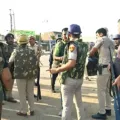
[ad_1]
The Hindus and other minorities in Bangladesh are now reduced to soft targets of the country’s religious and communal political landscape.
The news of attacks on Bangladeshi minorities is stitching unity among the world communities. Though the uproar was late and initially meek, it has now outlined the political diplomacy draft.
The first news of violence which particularly shook all Bengalis was the attack in the ISCON temple in Noakhali. Not to mention, the vandalisation of the Durga idols and the puja pandals were shocking too. In response, the ISCON Kolkata chapter demanded immediate intervention of the PMO to stop the merciless mass killings. “We did not yet receive any updates from the PMO on the Bangladesh minority attacks!” said Radharaman Das, Vice President & Spokesperson of ISKCON Kolkata.
However, during the weekly briefing, Arindam Bagchi, the spokesperson of MEA India, has said that the commission and the consulates are in close touch with ground associates. The violence has now spread rapidly to Chattogram and other districts.
The acclaimed politics behind the attacks
A lot of political commentators now smell the political smog behind the attack. According to the bdnews24 reports, the violence broke after the purported video of disrespecting the Quran in Hindu Temples went viral. The ruling Awami League is currently blaming the violence-mongers for purposely making the video viral to disrupt the thin line of communal balance. “The entire act is pre-planned. All of these are done to defame our supremo, Sheikh Hasina,” said Aysha Zamam, Mohila Awami League Comilla Organising Secretary said to Digpu News.
Though Bangladesh was formed with a secular ideology, it is steadily drifting away from it. Experts have claimed that the attacks were in the purview of the upcoming election. “BNP is responsible for instigating the violence. They are trying to disturb the Indian and Bangladesh relation in a bid to win the upcoming election,” she added. Bangladesh national polls are due in the next two years.
The recent communal violence is an attempt to turn BNP’s fate in the next general elections. “Though the Hindu population is declining in the country, they still have considerable political influence in around 50 constituencies,” senior journalist Subir Bhaumik said. According to him, this will make the election battle easy for Sheikh Hasina led Awami League.
In a nutshell, the Hindus and other religious minorities are the soft targets for electoral gains. Another narration that set the political price is – these attacks are the tit for tat by Jamaaties. Jamaaties are the supporters of Bangladesh’s largest Islamist political party, Bangladesh Jamaat-e-Islami. After Sheikh Hasina came to power, lots of Jamaat-e-Islami senior leaders were tried and executed in the war tribunal for 1971 Liberation war crimes against minorities.
The inclusion of BNP and Jamaati leaders in Awami League
The minority community’s faith was bolstered by the execution of some top leaders of Jamaat-e-Islami, and BNP’s Salauddin Quader Chowdhury for brutalities committed on pro-liberation elements and Hindus. The message was loud and clear. But slowly, after the 2014 elections, many local leaders of the BNP and Jamaat-e-Islami joined the Awami League without any background ideology check.
These had led the Islamic advocacy group of madrassa teachers and students, Hefazat-e-Islam Bangladesh (HIB), to test the opposition currents. HIB is responsible for the violent protest against Modi’s visit to Bangladesh, ahead of the West Bengal election this year. They have instigated violent protests against the free speech advocacy of French President Macron and the removal of non-Sharia political statues.
On the other hand, Awami League (AL) hopped to strike a deal with HIB to counter the BNP-Jamaat combo. As a token, the government had tolerated some of their radical demands. For example, the removal of the statue of ‘Lady Justice’, deemed un-Islamic by HIB, from the country’s Supreme Court building in 2017. The deal did work as they decimated the combo in the last election with the help of HIB backing in 2018.
This secular-radical bonhomie and unfiltered entry of BNP and Jamaati leaders have diluted the AL’s secular characteristics. But on a good note, the party is trying hard to shed off its radical feathers. “We are constantly in talk with the senior leaders about the inclusion of the BNP and Jamaati leaders in the party,” she added.
The attack on Hindus
As per The Federal, Rana Dasgupta, the general secretary of the umbrella organisation for minorities, has alleged that the grassroots workers of AL are involved in the attacks. The umbrella group of the country’s minority is known as The Bangladesh Hindu Buddhist Christian Unity Council (BHBCUC). Other leaders of the BHBCUC have pointed out the questionable administration’s role in the recent incident. “No grassroots leaders of AL were part of the attacks. Muslim men in my area were beaten while they were trying to save the Hindu victims,” she countered the claim.
Bangladesh is witnessing a massive protest across the country against the heinous attack. Secular leaders, bloggers have now taken to the streets to express their solidarity.
The Ain o Salish Kendra (ASK), a prominent Bangladeshi human rights group, has reported as many as 3,679 attacks on the Hindu community between January 2013 and September 2021. The data is confirmed and published by the Bangladeshi online news portal, bdnews24.com. The list included vandalisation of and setting fire to 559 houses, 442 shops, and businesses of the Hindu community. At least 1,678 vandalisation and arson attacks on Hindu temples and idols were noted in the same period.
The Indian politics on Bangladesh minority attack
In India, BJP and its opposition are now racing against each other to make some political gains. In Tripura, the CM has drafted a careful comment on the violence. He mentioned the Bangladeshi PM as an Indian ally.
Till now, there is no clear statement about the issue from the government except assurance of remaining connected with the ground situation. The Bangladesh minority attack has also emboldened the central’s policy of implementing CAA and NRC. But CAA final guidelines are due in 2022. Yes, the CAA bill was opposed. The guidelines to implement the CAA bill have fueled the criticism. In Assam, the natives were thrown into detention camps during the trial implementation of the CAA Bill.
Steps to curb the Bangladesh violence
But amidst all these, the Bangladesh PM Sheikh Hasina has taken considerable and effective steps to curb the violence. “The Bangladesh PM and her ministry is taking considerable steps to curb the violence,” Das said to Digpu News.
The official statement by the Bangladesh Foreign Minister quoted that Border Guards Bangladesh (BGB) troops have been deployed in 22 districts across the country to stop the spread of violence. The elite anti-crime Rapid Action Battalion (RAB) and the armed police will also guard, along with the BGB, in 22 of the 64 administrative districts.
(Note: All ISCON Temples in Bangladesh are providing relief material to the victims of the violence)
Feature Image: Twitter
[ad_2]






